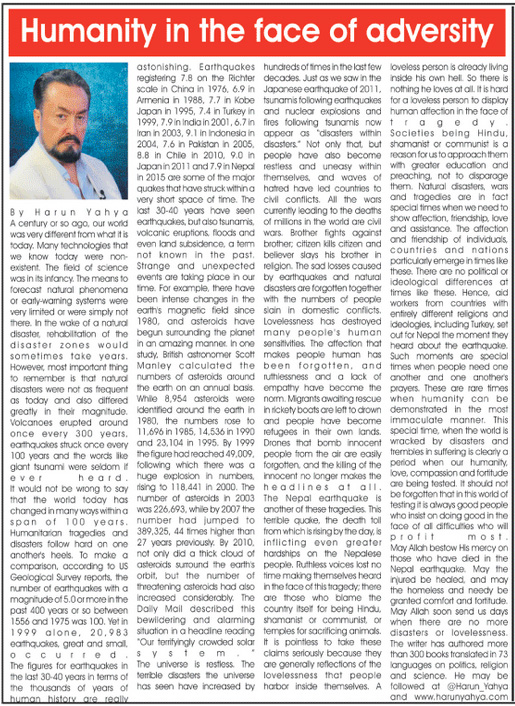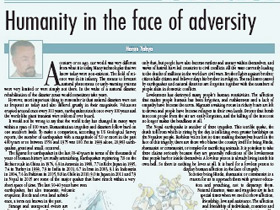
A century or so ago, our world was very different from what it is today. Many technologies that we know today were non-existent. The field of science was in its infancy. The means to forecast natural phenomena or early-warning systems were very limited or were simply not there. In the wake of a natural disaster, rehabilitation of the disaster zones would sometimes take years.
However, most important thing to remember is that natural disasters were not as frequent as today and also differed greatly in their magnitude. Volcanoes erupted around once every 300 years, earthquakes struck once every 100 years and the words like giant tsunami were seldom if ever heard.
It would not be wrong to say that the world today has changed in many ways within a span of 100 years. Humanitarian tragedies and disasters follow hard on one another’s heels. To make a comparison, according to US Geological Survey reports, the number of earthquakes with a magnitude of 5.0 or more in the past 400 years or so between 1556 and 1975 was 100. Yet in 1999 alone, 20,983 earthquakes, great and small, occurred.
The figures for earthquakes in the last 30-40 years in terms of the thousands of years of human history are really astonishing. Earthquakes registering 7.8 on the Richter scale in China in 1976, 6.9 in Armenia in 1988, 7.7 in Kobe Japan in 1995, 7.4 in Turkey in 1999, 7.9 in India in 2001, 6.7 in Iran in 2003, 9.1 in Indonesia in 2004, 7.6 in Pakistan in 2005, 8.8 in Chile in 2010, 9.0 in Japan in 2011 and 7.9 in Nepal in 2015 are some of the major quakes that have struck within a very short space of time. The last 30-40 years have seen earthquakes, but also tsunamis, volcanic eruptions, floods and even land subsidence, a term not known in the past.
Strange and unexpected events are taking place in our time. For example, there have been intense changes in the earth’s magnetic field since 1980, and asteroids have begun surrounding the planet in an amazing manner. In one study, British astronomer Scott Manley calculated the numbers of asteroids around the earth on an annual basis. While 8,954 asteroids were identified around the earth in 1980, the numbers rose to 11,696 in 1985, 14,536 in 1990 and 23,104 in 1995. By 1999 the figure had reached 49,009, following which there was a huge explosion in numbers, rising to 118,441 in 2000. The number of asteroids in 2003 was 226,693, while by 2007 the number had jumped to 389,325, 44 times higher than 27 years previously. By 2010, not only did a thick cloud of asteroids surround the earth’s orbit, but the number of threatening asteroids had also increased considerably. The Daily Mail described this bewildering and alarming situation in a headline reading “Our terrifyingly crowded solar system.”
The universe is restless. The terrible disasters the universe has seen have increased by hundreds of times in the last few decades. Just as we saw in the Japanese earthquake of 2011, tsunamis following earthquakes and nuclear explosions and fires following tsunamis now appear as “disasters within disasters.” Not only that, but people have also become restless and uneasy within themselves, and waves of hatred have led countries to civil conflicts. All the wars currently leading to the deaths of millions in the world are civil wars. Brother fights against brother; citizen kills citizen and believer slays his brother in religion. The sad losses caused by earthquakes and natural disasters are forgotten together with the numbers of people slain in domestic conflicts.
Lovelessness has destroyed many people’s human sensitivities. The affection that makes people human has been forgotten, and ruthlessness and a lack of empathy have become the norm. Migrants awaiting rescue in rickety boats are left to drown and people have become refugees in their own lands. Drones that bomb innocent people from the air are easily forgotten, and the killing of the innocent no longer makes the headlines at all.
The Nepal earthquake is another of these tragedies. This terrible quake, the death toll from which is rising by the day, is inflicting even greater hardships on the Nepalese people. Ruthless voices lost no time making themselves heard in the face of this tragedy; there are those who blame the country itself for being Hindu, shamanist or communist, or temples for sacrificing animals. It is pointless to take these claims seriously because they are generally reflections of the lovelessness that people harbor inside themselves. A loveless person is already living inside his own hell. So there is nothing he loves at all. It is hard for a loveless person to display human affection in the face of tragedy.
Societies being Hindu, shamanist or communist is a reason for us to approach them with greater education and preaching, not to disparage them. Natural disasters, wars and tragedies are in fact special times when we need to show affection, friendship, love and assistance. The affection and friendship of individuals, countries and nations particularly emerge in times like these. There are no political or ideological differences at times like these. Hence, aid workers from countries with entirely different religions and ideologies, including Turkey, set out for Nepal the moment they heard about the earthquake. Such moments are special times when people need one another and one another’s prayers. These are rare times when humanity can be demonstrated in the most immaculate manner. This special time, when the world is wracked by disasters and trembles in suffering is clearly a period when our humanity, love, compassion and fortitude are being tested. It should not be forgotten that in this world of testing it is always good people who insist on doing good in the face of all difficulties who will profit most.
May Allah bestow His mercy on those who have died in the Nepal earthquake. May the injured be healed, and may the homeless and needy be granted comfort and fortitude. May Allah soon send us days when there are no more disasters or lovelessness.
1. http://www.dailymail.co.uk/sciencetech/article-1306555/Our-terrifyingly-crowded-solar-How-asteroids-closing-in.html
Adnan Oktar's piece on Arab News & Urdu Times:
http://www.arabnews.com/columns/news/740831



